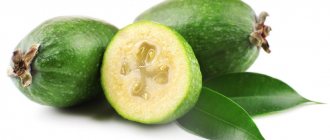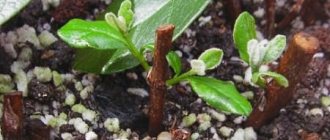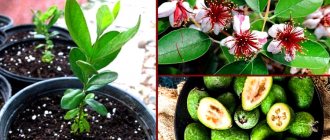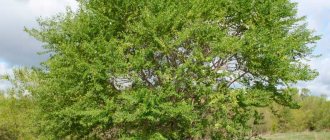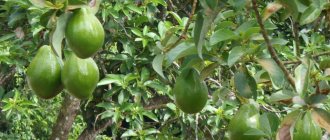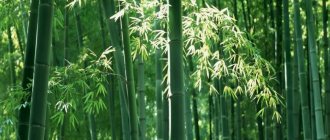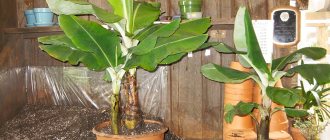The exotic feijoa fruit was first discovered by the Portuguese naturalist João da Silva Feijó in Brazil and is now becoming increasingly popular among lovers of the unusual delicacy. In countries where feijoa grows, it is traditionally eaten raw, and fruit salads, drinks, and jams are also prepared from it. It has become widespread throughout the world for its original, incomparable taste - a combination of shades of kiwi, pineapple and strawberry. Feijoa ripens in late autumn - early winter.
Homeland of feijoa
Feijoa is an evergreen subtropical plant. It was first discovered in Brazil in the 19th century. What feijoa looks like, where it grows, what taste qualities its fruits have, was described in detail by naturalist scientist from Portugal Joao da Silva Feijo. Subsequently, the culture was named after its discoverer.
The fruit plant belongs to the genus Akka of the Myrtaceae family, but sometimes it is classified as a separate genus Feijoa.
It is a large shrub or tree, reaching about 4 m in height - it all depends on the growing conditions. It has a shallow root system and a brown or greenish trunk with a rough structure. The leaves are leathery, hard, entire, oblong, gray-green in color. The top is smooth, the lower surface is pubescent.
During flowering, the plant is covered with decorative flowers, arranged singly or collected in inflorescences. After flowering, fruits appear - juicy, fleshy berries of small size, oblong, round or oval, with a dense dark green or greenish-yellow peel. Most often these are small berries weighing no more than 40 g. But some varieties are distinguished by larger fruits - up to 120 g. The aroma and taste of ripe fruits resembles a mix of strawberries and pineapple.
The larger the fruit, the more nutrients it contains. An interesting fact is that varieties growing near the sea have the most delicious and healthy fruits. They can be eaten fresh, made into jams, marmalade, drinks and even wine. They do not cause allergies. The only drawback is the short shelf life after collection.
Feijoa is native to South America. In addition to Brazil, it grows in the forests of Uruguay, Colombia, as well as in the northern regions of America. Rarely found in tropical forests, prefers the subtropical zone.
A little history
European sailors discovered this exotic species in 1813-1815 while traveling off the coast of Brazil. Its native Joan da Silva Feijo (1760-1824), who studied and worked in Portugal at that time, was a member of the expedition. The plant was later named in his honor.
The second name of the plant is acca feijoa, and also acca Sellova. Akka is a goddess from Roman mythology, and Sellow, also known as Friedrich Zello (1789-1831), was a German traveler and explorer, also a member of the expedition that discovered such a valuable plant. He studied the flora of Brazil, in particular, he studied feijoa - how it grows, whether it can be zoned in Europe, etc.
Over time, the plant was brought to France and Portugal. From there it was distributed to other territories where climatic conditions allowed it. Fans of feijoa flowering grow it as an ornamental plant in gardens, greenhouses and even at home.
Where does feijoa grow in Russia?
The first feijoa seedlings appeared in Russia at the beginning of the twentieth century. and were planted in Crimea, Yalta and gardens on the eastern coast of the Black Sea - Sukhumi. Gradually, the exotic culture took root in the southern regions of the country: Dagestan, Krasnodar Territory. Bushes of an exotic plant are found in the gardens of Transcaucasia and Turkmenistan.
Research centers in Yalta and Sochi are studying the properties of feijoa and are engaged in its selection. Scientists managed to develop several early varieties and one with an average ripening period.
In the subtropical climate of Russia, the Feijoa Sellova variety is most often grown. In colder regions, the plant is cultivated indoors. The flowering period on Russian territory is from May to June.
Thanks to numerous studies, it was found that the plant can tolerate low temperatures, up to 10°C. During severe cold weather, the bush may freeze completely, but in the spring it is able to begin to grow again.
Where does it grow in the world
At the end of the nineteenth century. the plant came to France, from where it spread throughout the Mediterranean territory of Europe. Countries where feijoa grows include Greece, Italy, Spain and Portugal.
The plant is grown in the southern regions of Russia, Armenia, Georgia, Azerbaijan, Turkmenistan, Abkhazia. Found in Australia, New Zealand, Japan, Algeria. In countries with warm climates, feijoa can grow in open ground. In areas where the climate is cold, it is placed in winter gardens or on window sills.
Since the crop loves light, south or south-east windows are most suitable for growing indoors. To prevent shedding of leaves in the autumn-winter period, the plant must be provided with additional lighting.
What is the cost per 1 kg
Quechua can be bought in supermarkets and markets. It is sold by weight and in formed baskets of 0.5 kg.
| Product | price, rub. |
| Feijoa (Colombia), 1 kg | 680,00 |
| Feijoa jam “Balham” (Russia), 300g | 224,00 |
| Dried feijoa (Georgia), 1 kg | 600,00 |
The flowering of feijoa is fascinating, which is why the plant was originally used for decorative purposes. It decorated the gardens of Japan, Australia and Algeria. Chinese painters also painted still lifes and compositions depicting its flowering branches and juicy fruits.
Photo: how feijoa grows
The crop is grown not only for its fruits. Thanks to its lush, beautiful flowers, which can be grown even indoors, it is often used to decorate rooms, balconies, winter gardens, and greenhouses.
In numerous photos you can see in detail the beautiful feijoa flowers. On the outside they are white, the inner surface changes color from light along the outer edge to bright crimson closer to the middle. A large number of stamens gives the flower a fabulous look and attracts attention.
Feijoa is an unpretentious plant and can easily be grown at home. To get fruits, you should pay attention to self-pollinating varieties. The plant loves light, but direct sunlight can cause burns. Therefore, on hot days it needs to be shaded a little; in summer - take it out into the garden or onto the balcony.
Lack of lighting will cause shoots to stretch; the bush will lose its decorative appearance and will not bear fruit.
How does it bloom?
It lasts about three weeks and occurs at the end of spring - beginning of summer. To set fruit, insects and, most often, several different trees are needed, since plants are not capable of pollinating themselves. The flowers are very beautiful, small, sweetish in taste, pink in the center of the inflorescence and white towards the edges of the petals, with many stamens (about 60).
When propagated by grafting, the tree can bloom in 4-5 years, by seeds - in 5-6 years. Every fifth or sixth flower is set into fruit.
Description and classification of feijoa
Feijoa is an evergreen subtropical shrub or tree no more than 4 m tall. Its place of growth is Brazil, where the culture was discovered and described in the 19th century by the Portuguese naturalist Joao da Silva Feijo. It got its name in honor of him. Feijoa is sometimes classified in the genus Akka of the Myrtaceae family, but in some cases it is allocated to a separate genus Feijoa (Feijoa sellowiana). The culture received its specific name after the surname of the famous German scientist, researcher of the flora of Brazil, Friedrich Sellow.
Some varieties of feijoa
In Russia there are 2 scientific centers (in Yalta and Sochi) studying the properties and breeding of feijoa. Employees of the Sochi All-Russian Research Institute of Floriculture and Subtropical Crops and the Nikitsky Botanical Garden in Yalta created feijoa varieties that were included in the State Register of the Russian Federation:
- Fragrant fantasy - Crimean early variety. The fruits weigh up to 35 g. They have juicy, tender pulp. Transportable. Productivity is approximately 100 c/ha. Frost resistance 3 points. Weak drought resistance.
- Dagomysskaya - medium ripening period. Created in Sochi. The berries are large, weighing on average more than 85 g. The peel is medium thick. The pulp is creamy, sweet and sour, with minor stony inclusions. With a pronounced aroma. Productivity more than 300 c/ha. Needs cross-pollination.
- Dachnaya is an early variety created in Sochi. The berries are large, average weight 43.1 g. The skin is thin. The pulp is tender and creamy. Productivity more than 200 c/ha.
- Nikitskaya aromatic - Crimean early variety. The average weight of the berries is 35 g. The pulp is juicy, the taste is sweet and sour, not very pronounced. The yield is just over 100 c/ha. Frost resistance 3 points.
- September is an early variety that needs cross-pollination. Fruits with thin skin. Pulp without stony inclusions. The average yield is about 160 c/ha. Drought-resistant variety.
The once strange fruits of feijoa, although they have not yet become a widespread food product, are gradually gaining steady interest due to their attractive aroma, pleasant unusual taste and delicate pulp.
Where does feijoa grow in Russia and where does the fruit come from?
The exotic feijoa fruit was first discovered by the Portuguese naturalist João da Silva Feijó in Brazil and is now becoming increasingly popular among lovers of the unusual delicacy. In countries where feijoa grows, it is traditionally eaten raw, and fruit salads, drinks, and jams are also prepared from it. It has become widespread throughout the world for its original, incomparable taste - a combination of shades of kiwi, pineapple and strawberry. Feijoa ripens in late autumn - early winter.
Feijoa in the kitchen: dessert or sauce for meat?
Recipes with feijoa are so varied that you can definitely choose any dish. The most unusual and at the same time successful option is a kind of jam. It turns out aromatic, viscous and will definitely surprise any guest. What’s remarkable is that the recipe turns out right the first time.
Jeremy Uryuti
Chef at Le Restaurant
The fruit is also traditionally baked with meat. In combination with pineapple and passion fruit, feijoa reveals its taste in a special way - such a mix shows itself ideally in cocktails and fruit salads.
— Jeremy Uryuti Chef at Le Restaurant
Stages of making jam
This jam is good for baking and toast. What ingredients will you need:
- fruits – 250 g;
- honey – 200-500 g.
Be sure to read:
Chompu - a pink apple with an unusual shape
The resulting ingredients yield about 500 ml of delicious jam.
First you need to prepare the main fruit. First, we wash the fruits well to remove all dust and dirt. There is no need to peel the peel, because it also contains many useful components. Only the darkened parts of the peel need pruning.
Due to pectin, feijoa quickly darkens, so all preparations must be done in one day.
Next, the berries need to be chopped into the smallest pieces. To do this, it is better to use a meat grinder or blender. Add honey to the resulting mixture.
If the honey is too hard, it is better to melt it. Mix everything until smooth. The mixture should be thick. To get the desired thickness, it is better to leave the jam in the refrigerator for half an hour. Pour the finished mixture into a jar and use it from the first day of preparation.
History and benefits of feijoa
Countries with a mild subtropical climate where feijoa fruit grows : New Zealand, Australia, Argentina, USA, Colombia, Uruguay. At the beginning of the twentieth century, the plant became widespread in the Mediterranean countries (France, Spain, Greece, Portugal, Italy) and Central Asia. It is interesting that the unusual-tasting fruits began to be eaten much later. Initially, local residents decorated their plots with beautiful flowering trees. The Caucasus, Dagestan, Krasnodar Territory are the places where feijoa grows in Russia. Transcaucasian countries from where feijoa is brought to Russia: Abkhazia, Georgia, Armenia, Azerbaijan, Turkmenistan.
The fruit is rich in antioxidants, microelements, fiber, natural sugars, organic acids, and pectins. The iodine content here is higher than in seafood. The high content of vitamin C helps the body fight colds and acute respiratory viral infections. Widely used in dietary nutrition.
Beneficial features:
Vitamins and microelements
The berries are rich in iodine content: about 0.3 mg per kilogram of weight. For example, a person needs 0.15 mg of iodine per day, so feijoa can replace, if consumed daily, all other dietary products that are sources of this trace element. It also contains organic acids and sugars, which give feijoa a pleasant taste. It is sweet with sourness, which intensifies as it ripens and the amount of moisture in the fruit decreases. The berries taste like a mixture of strawberries, pineapple and kiwi.
Application in cosmetology
Feijoa is an effective remedy for maintaining beauty and youth .
Juicy pulp and juice, rich in vitamins, tone and soothe inflammation on the skin. They also help restore intracellular pressure, significantly improve appearance and reduce the manifestations of rosacea. Feijoa-based masks cleanse and nourish, suitable for any age and skin type. You can prepare a rejuvenating mask. Ingredients: 2 tablespoons of fruit pulp, 1 teaspoon of almond oil, 1 tablespoon of oatmeal, chamomile (for decoction).
Pour a small amount of chamomile infusion over the oatmeal in advance and stir. Mix the resulting pulp with the remaining ingredients and apply to the face for 20 minutes. Rinse off with warm water. Apply the mask 1-2 times a week.
Use in cooking
The unusual bright green fruit can be eaten just like that, or you can make aromatic jam with citrus notes, a salad or a tonic drink from it. Calorie content is only 49 kcal per 100 g of fruit.
Feijoa is brought to Russia from the countries of Transcaucasia. When choosing, pay attention to the size, appearance, ripeness of the fruit:
- give preference to large fruits, as they contain more nutrients than small ones;
- a good fruit should be without damage or dents, dense and elastic;
- the presence of large dark spots indicates a low-quality product, which should be avoided;
- unripe fruit is hard, too soft - overripe;
- the skin of a ripe fruit is dark green, the pulp is transparent, with a creamy tint.
What is the nutritional value
The main advantage of feijoa is the absence of cholesterol, saturated fat, sugar, as well as a high content of vitamin C and aromatic essential oils.
The berries are used as an immunomodulator to treat influenza, colds and viral diseases.
How many calories does it contain?
The calorie content of 100 g of berries is 55 kcal, of which:
- proteins – 0.98 g;
- fat – 0.6 g;
- carbohydrates – 13 g;
- fiber – 6.4 g;
- water – 86.6 g.
Among the carbohydrates of the fruit:
- sucrose – 2.93 g;
- fructose – 2.95 g;
- glucose – 2.32 g.
In addition, it is an alkaline food that helps balance acidity levels in the body.
The fruits ripen in November
What are the features of the vitamin and mineral composition
Pineapple guava has a very diverse chemical composition, which is rich in fiber, vitamins, pectin, sucrose, micronutrients, phenolic compounds and biologically active elements.
| Chemical composition (per 100 g of berries) | Amount, mg |
| Thiamine (vitamin B1) | 0,01 |
| Riboflavin (vitamin B2) | 0,02 |
| Pantothenic acid (vitamin B5) | 0,23 |
| Pyridoxine (vitamin B6) | 0,07 |
| Folic acid (vitamin B9) | 0,023 |
| Ascorbic acid (vitamin C) | 32,9 |
| Nicotinic acid (vitamin PP) | 0,46 |
| Phylloquinone (vitamin K) | 0,03 |
| Potassium | 172,0 |
| Silicon | 22,0 |
| Phosphorus | 19,0 |
| Calcium | 17,0 |
| Magnesium | 9,0 |
| Chlorine | 8,0 |
| Sulfur | 5,0 |
| Sodium | 3,0 |
| Iodine | 0,035 |
| Aluminum | 0,38 |
Quechua contains more iodine than seafood - 18.7% of the human daily requirement. It should be borne in mind that only those fruits grown close to the sea have this percentage of mineral content.
What are the benefits of feijoa and when is it sold?
Tasty and aromatic feijoa fruits have long been loved by Russians. The main feature of this dark green berry is its composition. It is known that feijoa fruits, due to their content, are the most valuable source of such an element as iodine. And what’s most interesting is that this exotic berry surpasses even seafood in its content. At the same time, feijoa fruits contain water-soluble iodine compounds, which are perfectly accepted by the human body. But this is just the beginning of the beneficial properties of the berry. Feijoa fruits contain a huge amount of vitamin C, sucrose, fiber and pectin. Due to its unique composition, feijoa is ideal as a dietary product for diseases such as atherosclerosis and pyelonephritis. Feijoa is also valued as an excellent remedy for strengthening the immune system. And in terms of antioxidant content, these fruits can compete with the best products. Moreover, the most antioxidants are contained in the skin of the fruit. For this reason, it is recommended to eat feijoa fruits whole and not peel them.
The selling season for feijoa usually falls during the cold season. Berries begin to appear on the shelves in late autumn, and some varieties of the crop can be sold until spring. This long period of sale is explained by the long process of growth and maturation of feijoa, which begins in spring. In addition, feijoa is perfectly stored even after harvesting in an unripe form.
More details about feijoa will be discussed in this video.
TOP 15 beneficial properties of feijoa
- Digestive health. Feijoa pulp contains plant fibers that have a stimulating effect on intestinal functionality. Thanks to fiber, the secretory activity of the stomach is activated and intestinal peristalsis is enhanced. The combination of two effects makes feijoa useful in facilitating the digestion of food and preventing constipation. In addition, feijoa pulp fibers prevent the development of colorectal cancer.
- Normalizes blood sugar. It is known that patients with type II diabetes mellitus attach particular importance to the glycemic index of the foods they consume. This indicator allows you to classify drinks and food regarding their ability to influence blood sugar levels. So white rice and white bread are quickly digested and provoke sharp changes in glucose and insulin levels in the blood. Feijoa has a minimal glycemic index, which means it enters the blood more slowly. Eating berries helps balance sugar levels, reduces cravings for sweet foods, and normalizes the psycho-emotional state.
- Maintains normal blood pressure levels. Feijoa is a product that should be included in the diet of every hypertensive patient. Thanks to its high potassium concentration and very low sodium content, it helps lower blood pressure and keep it at an optimal level. It has been established that one average feijoa fruit contains 418 mg of potassium and only 7 mg of sodium. This ratio of essential minerals ensures a decrease in the tone of blood vessels and a decrease in blood pressure to normal levels.
- Minimizes the likelihood of cardiovascular diseases. Vitamin B6, ascorbic acid, potassium and plant fiber help maintain heart health - all these elements are found in feijoa pulp. The National Health and Nutrition Examination Survey conducted in the United States found that the majority of the population does not get the required 4,700 mg of potassium.
Medical experiments have shown that daily consumption of 4069 mg of potassium almost halves the likelihood of death due to cardiac ischemia. On the contrary, maintaining a dosage of less than 1000 mg of potassium per day increases such risks.
The results of numerous studies indicate that feijoa fiber lowers the level of total cholesterol and LDL in patients with type II diabetes mellitus. At the same time, there is an increase in HDL (good cholesterol) levels.
- Protects against infections. One recommended daily dose of feijoa (3 large berries) contains 82% of the daily required amount of vitamin C. Ascorbic acid dissolves in the aqueous environment of the body, which contributes to a rapid antioxidant effect. The speed of biochemical processes increases the body's resistance to infectious pathogens and prevents the development of malignant tumors.
- Counteracts the effects of free radicals. For complete antioxidant protection, manganese is required, which is the main component in the formation of essential enzymes. The formed coenzymes suppress the negative effects of free radicals that are synthesized in the mitochondria of cells as a result of metabolic processes. One serving of feijoa contains approximately 10% of the daily value of manganese.
- Improves memory, concentration, memory. Feijoa contains elements that are invaluable for neurological health - antioxidants, folate, potassium. Medical studies have shown that folic acid prevents the development of degenerative disorders, Alzheimer's disease, and cognitive impairment.
Potassium improves cerebral circulation, provides nutrition to all brain centers responsible for cognitive functions, attention, and activity. Feijoa contains a large amount of vitamin B6, the deficiency of which causes depressive disorders in humans and a feeling of discomfort in the digestive organs.
- Supports immunity. The rich vitamin composition of feijoa ensures the preservation and stimulation of the body's immune functions. Medical studies have shown that systematic consumption of feijoa reduces the incidence of colds caused by bacteria and viruses.
- Maintains healthy teeth and oral cavity. Calcium and vitamin C, which are very abundant in feijoa, are beneficial for teeth, oral mucosa, and periodontal tissues. Thanks to calcium, the mineralization of tooth enamel is maintained. Vitamin C suppresses the growth of pathogenic microflora, promotes the healing of damaged mucous membranes of the cheeks, palate, gums, and prevents the development of oral cancer.
- Provides the body with energy. Feijoa fruits contain a record amount of valuable nutrients. In the body, they are included in the general metabolism and provide a person with energy. Thanks to this, a person receives the necessary vitality and physical endurance. The maximum effect is observed with regular consumption of feijoa.
The biochemical compounds of feijoa support not only physical health, but also psychological balance. It has been proven that tropical berries protect against depressive disorders and stress, improve mood, and relieve anxiety attacks.
- Maintains normal weight. It is an ideal product in a comprehensive diet for weight loss. Feijoa helps digest food, reduces the level of total cholesterol, LDL and triglycerides, which are identified as the main cause of obesity. Excess weight increases the risk of heart and vascular diseases.
- Maintains bone health. The main condition for healthy bones is a regular supply of calcium. Feijoa is an ideal source of calcium for those who suffer from milk protein allergies. Its daily use ensures the density and mineralization of bone tissue and prevents the development of bone diseases.
- Provides eye health. Feijoa contains a lot of vitamin A, which is the main vitamin for the eyes. Medical observations indicate that regular consumption of feijoa fruits maintains visual acuity and reduces the likelihood of ophthalmological diseases.
- Eliminates dehydration. Every person loses a large amount of fluid during the day. To maintain water balance, it is recommended to drink at least 1.5-2 liters of water per day. Feijoa contains a lot of moisture, which can become a complete alternative to drinking water. To provide the body with a sufficient amount of fluid, you can drink feijoa fruit juice.
- Helps recovery. The human body, after suffering serious illnesses or surgical interventions, experiences physiological and biochemical stress. Consumption of feijoa helps restore vitality, heal injuries of various origins and locations, and regenerate skin after surgical treatment.
Benefits for women
Women are very vulnerable to iodine deficiency. Its insufficient amount negatively affects health and appearance. Specific symptoms of iodine deficiency:
- Fatigue.
- The appearance of excess weight.
- Formation of stones in the gall bladder.
- Brittleness, splitting of nails.
- Hair loss.
- Decrease in visual acuity.
- Dry skin.
To prevent deficiency, women are recommended to consume 150 mcg of iodine. This amount is provided by 3-4 feijoa berries, which can be taken once every 7 days. Iodine in fruits is retained even after heat treatment.
Regular consumption of feijoa provides women with essential microelements that protect against:
- Gynecological diseases.
- Infertility.
- Menstrual irregularities.
Plant flavonoids preserve women's health, the beauty of hair and skin, and prevent the appearance of early signs of aging. In addition, flavonoids soften premenstrual symptoms and ease menopause.
Benefits for men
For men, eating feijoa is directly related to urological health. Scientists have proven that several berries a day prevent the development of prostatitis, which over time leads to impotence and hormonal imbalances.
Men often experience all kinds of stress, which significantly increases the risk of cardiovascular diseases, digestive problems, and the development of hypertension. Regular consumption of feijoa fruits protects against:
- Gastric ulcer.
- Pancreatitis.
- Myocardial ischemia.
- Uncontrolled surges in blood pressure.
A lack of iodine for men is fraught with the development of chronic fatigue, decreased attention, and the ability to concentrate, which is extremely dangerous for drivers and people working with heavy or precision equipment. To prevent serious consequences, to maintain normal iodine levels, it is recommended to consume one feijoa berry daily.
Benefits during pregnancy
Pregnancy is a special period in a woman’s life when all the beneficial substances entering the body with food are actively absorbed. Adequate nutrition is the main condition for the successful pregnancy and birth of a healthy child. Scientists have proven that feijoa is of particular benefit to a woman during pregnancy. Exotic fruits provide the supply of essential vitamins, minerals, iron, and iodine. Each of the elements has a valuable effect on the growth and intrauterine development of the child. For example, folic acid ensures the proper formation of the nervous system, iodine - the development of intelligence, iron - hematopoiesis.
We must not forget that during pregnancy a woman experiences problems with her intestines. The more the fetus grows, the more acute the issue of constipation becomes. You can solve the problem with feijoa, which contains a lot of fiber. The product prevents the development of anemia in pregnant women, which is extremely important for the health of the woman and child.
Where do feijoas come from to Russia?
Few people know, but this exotic fruit was first discovered by the Portuguese Joao do Silva Feijo in Brazil. Today, feijoa is grown in many countries. This exotic and healthy delicacy grows in New Zealand, Argentina, the USA, Colombia and Australia, and is also grown in Uruguay and even in certain regions of Russia. In countries where feijoa grows, they prefer to eat it exclusively raw. Juicy and aromatic berries are brought to Russia from Abkhazia, Armenia, Azerbaijan, Turkmenistan and Georgia. Feijoa is sold from these countries between October and November, since during this period the plant actively bears fruit. You can also buy feijoa in December. The average cost of feijoa in Russia fluctuates around 300 rubles, but sometimes it is more expensive.
How to choose a good feijoa?
Feijoa, like any other fruit, must be chosen correctly. and first of all, it is worth understanding that a berry that is good in its taste and beneficial properties is a ripe berry. Well, since feijoa fruits are usually picked a little unripe, an inexperienced buyer has a great chance of purchasing green feijoa, the taste of which, for obvious reasons, will be far from ideal. However, even if the feijoa is too hard, you should not be upset in any case. To make the fruits softer, it is enough to leave them to ripen for several days. After ripening, feijoa becomes soft, and its pulp becomes jelly-like in consistency. If you are lucky enough to purchase ripe feijoa, then after purchase it must be stored in the refrigerator. This feijoa should be consumed as early as possible, because the fruits may begin to deteriorate in taste, while their appearance may remain quite appetizing and unspoiled. and another important point when choosing a good feijoa is that its peel should have a rich green color. Fruits with this color will have a soft and piquant taste, will be sweet and aromatic.
How to store feijoa and what can be done with it?
After purchasing feijoa, it is worth considering the fact that its fruits require special storage conditions. You should not choose overripe fruits, as fermentation processes may begin in them. In addition, if the feijoa peel has been damaged, this may indicate a loss of beneficial properties. Unripe feijoa fruits are best stored in the refrigerator or in a well-ventilated area. For proper storage, the room temperature should be between 21-24 degrees. If everything is done correctly, the feijoa fruits will be able to ripen in about one or two weeks. Some housewives prefer to store feijoa in the form of jam. Indeed, such a treat from it turns out to be very tasty, aromatic and, most importantly, as healthy as possible. Feijoa can also be used to make jam, salads and tonic drinks at home. It can be safely added to baked goods and various desserts. Feijoa makes unusual and very tasty sauces and snacks.
Where else can you use feijoa?
Feijoa, due to its unique composition, is considered one of the best fruits for use in cosmetology. Masks made from it have excellent anti-inflammatory, nourishing and rejuvenating effects. Every woman can prepare such a mask herself. For it, it is enough to take 1/3 of crushed feijoa berries, add to them the yolk and 2 tablespoons of cottage cheese. Pour the resulting mixture with 1 tablespoon of olive oil and apply the mixture to your face. Leave the mask on your face for about 20 minutes and then remove it using a sponge and warm water.
Feijoa is a fruit or berry
Lovers of exotic fruits often ask questions: what is feijoa, where does the fruit grow? Where did this wonderful plant come from? The birthplace of fruitful flowering plants of the Myrtaceae family is considered to be:
Today, agronomists in Azerbaijan, Australia, the Caucasus, and western Georgia successfully grow the fruitful flowering plant on their plantations. Recently, the shrub has been grown in Russia (RF).
What is feijoa - a berry or a fruit? This is an exotic fruit that falls under the category of fruit.
Feijoa is a fruit that will not leave even the most sophisticated gourmet in the world indifferent. The outline of the fruit resembles the shape of an egg. The fruits are colored green. The pulp is characterized by increased juiciness, aroma and a sweetish taste. The taste of feijoa resembles notes of apple, mint, fig and pineapple.
What does feijoa look like? The peel of the exotic fruit is thick and has a tart taste. The pulp contains a small amount of seeds. The fruit can be eaten in its entirety without removing the peel.
Note! Most often, lovers of exotic fruits choose only the pulp, not suspecting that it is the skin that contains the main percentage of useful elements. Some housewives dry the peel in the fresh air and add it to tea together with grated ginger in winter.
How does feijoa bloom? The season of abundant feijoa flowering lasts almost 60 days. During this period, the plant becomes a real decoration of the apartment/garden. Bright feijoa flowers are endowed with an amazing aroma. The fruit ripening period occurs on the 20th of October. During the feijoa ripening season, you can pick the fruit from the tree and eat it right away.
Description and classification of feijoa
Feijoa is an evergreen subtropical shrub or tree no more than 4 m tall. Its place of growth is Brazil, where the culture was discovered and described in the 19th century by the Portuguese naturalist Joao da Silva Feijo. It got its name in honor of him. Feijoa is sometimes classified in the genus Akka of the Myrtaceae family, but in some cases it is allocated to a separate genus Feijoa (Feijoa sellowiana). The culture received its specific name after the surname of the famous German scientist, researcher of the flora of Brazil, Friedrich Sellow.
Feijoa is a low shrub or tree
Origin and distribution
Feijoa is native to South America:
- Brazil;
- northern regions of Argentina;
- Uruguay;
- Colombia.
It grows, occupying the tropical zone, but feels better in the subtropical zone.
Finding itself in France at the end of the 19th century, the plant successfully spread throughout Europe, even reaching Russia by the beginning of the 20th century. Cuttings of the unusual culture first took root in Yalta and on the Black Sea coast of the Caucasus. Subsequently, the quiet expansion of the overseas guest spread to the southern regions of Russia: Dagestan, Krasnodar Territory. Feijoa grows in Transcaucasia and Turkmenistan.
The conquest of plants in the Mediterranean zone of Europe was no less successful. Feijoa has been living in:
With European settlers, the plant came to the New World and gradually spread throughout the Pacific coast of the United States and some other states. In addition, feijoa grows in Australia and New Zealand.
Main characteristics
This is a subtropical evergreen, moisture-loving plant that forms a bush or tree. The trunk is rough, brown or greenish. Dense roots are located superficially in the soil.
The leaves are entire, oblong, green-gray. Smooth above, pubescent below. Leathery and tough to the touch. They have an opposite arrangement.
Feijoa leaves are entire and have an opposite arrangement.
Feijoa flowers are exotically decorative. There are single ones, arranged in pairs, and also collected in inflorescences. Each flower contains 4 velvety petals. They are sweet and edible. Their outer surface is lighter, and the color of the inner surface changes from almost white at the edge to dark pink closer to the center. The abundance of stamens attracts attention and gives a colorful appearance. Most flowers are self-fertile and require pollinating insects, although there are also self-fertile varieties.
The outer surface of the petal is lighter than the inner surface
Usually up to 75–80% of the ovary falls off.
Feijoa blooms in Russia from May to June. Under natural conditions in the subtropics of the Southern Hemisphere, this time falls in November - December. In tropical climates, both cyclical and continuous flowering occur.
The fruits are small, fleshy, juicy berries with a dense skin of dark green or greenish-yellow color. They are covered with a waxy coating. The shape is round, oblong or oval. The average weight of a berry is 15–60 g. There are monster fruits weighing more than 100 g. They have a unique aroma reminiscent of strawberries and pineapple.
Feijoa preparations will be filled with vitamins during the long winter months. You can find many ways to prepare these berries on the Internet. My option involves a minimum of effort and a complete absence of heat treatment. Washed and dried ripe feijoa berries should be passed through a meat grinder and granulated sugar should be added in a ratio of 1:1.5. Stir thoroughly and pour into jars. Keep refrigerated. You can layer the resulting mixture into baked goods or serve it with tea.
The pulp is usually whitish-cream or colorless. Some varieties are colored pink. The taste is sweet and sour. The consistency is usually creamy. There are varieties with rocky inclusions. Berries are universally used, used in fresh and processed forms.
Feijoa pulp is usually creamy or colorless
Feijoa fruits contain organic acids, sugars, vitamin C, pectin, and iodine. The vitamin C content in some varieties grown in the Russian Federation reaches 50 mg or more. 100 g of berries contain twice as much iodine as required for daily consumption. Moreover, the amount of iodine directly depends on how close to the sea the crop grows. It accumulates more in feijoa fruits that live near sea coasts.
People suffering from thyroid diseases should consult an endocrinologist before consuming aromatic fruits, or limit themselves to one or two berries per day.
Plants in the northern hemisphere actively grow and bear fruit from April to November. The growing season in the Southern Hemisphere ranges from October to the end of April.
Fruiting in seedlings is observed only in the sixth or seventh year after planting, but by grafting it is possible to obtain a harvest 2–3 years earlier. Fruiting is regular.
Studies have shown that these heat-loving plants are able to tolerate temperatures as low as -11 o C.
Video: how to grow feijoa at home
What is
Feijoa is biologically considered a berry, but most often it is called a fruit. It has an elongated oval shape and a diameter of no more than 5 cm. The average weight is 30-40 g. The berry is covered with a thick green peel, which reliably hides the light-colored pulp. Inside are edible seeds, which are located in a juicy jelly-like mass. The taste and aroma of feijoa resembles pineapple, kiwi and strawberries.
In what regions does it grow?
The plant with yellow-pink flowers feels comfortable in subtropical and tropical climates. Its homeland is South America, where feijoa is called Quechua. According to ancient legend, this fruit was given to the Indians as a gift from the gods. Now the plant is actively cultivated in many countries of the world:
- Greece;
- Spain;
- New Zealand;
- Portugal;
- Chile;
- Bolivia;
- USA (California);
- Colombia.
The tree begins to bloom in the spring, and bear fruit six months after the completion of this process, that is, at the end of autumn or at the beginning of winter.
Some varieties of feijoa
In Russia there are 2 scientific centers (in Yalta and Sochi) studying the properties and breeding of feijoa. Employees of the Sochi All-Russian Research Institute of Floriculture and Subtropical Crops and the Nikitsky Botanical Garden in Yalta created feijoa varieties that were included in the State Register of the Russian Federation:
- Fragrant fantasy - Crimean early variety. The fruits weigh up to 35 g. They have juicy, tender pulp. Transportable. Productivity is approximately 100 c/ha. Frost resistance 3 points. Weak drought resistance.
- Dagomysskaya - medium ripening period. Created in Sochi. The berries are large, weighing on average more than 85 g. The peel is medium thick. The pulp is creamy, sweet and sour, with minor stony inclusions. With a pronounced aroma. Productivity more than 300 c/ha. Needs cross-pollination.
- Dachnaya is an early variety created in Sochi. The berries are large, average weight 43.1 g. The skin is thin. The pulp is tender and creamy. Productivity more than 200 c/ha.
- Nikitskaya aromatic - Crimean early variety. The average weight of the berries is 35 g. The pulp is juicy, the taste is sweet and sour, not very pronounced. The yield is just over 100 c/ha. Frost resistance 3 points.
- September is an early variety that needs cross-pollination. Fruits with thin skin. Pulp without stony inclusions. The average yield is about 160 c/ha. Drought-resistant variety.
The once strange fruits of feijoa, although they have not yet become a widespread food product, are gradually gaining steady interest due to their attractive aroma, pleasant unusual taste and delicate pulp.
